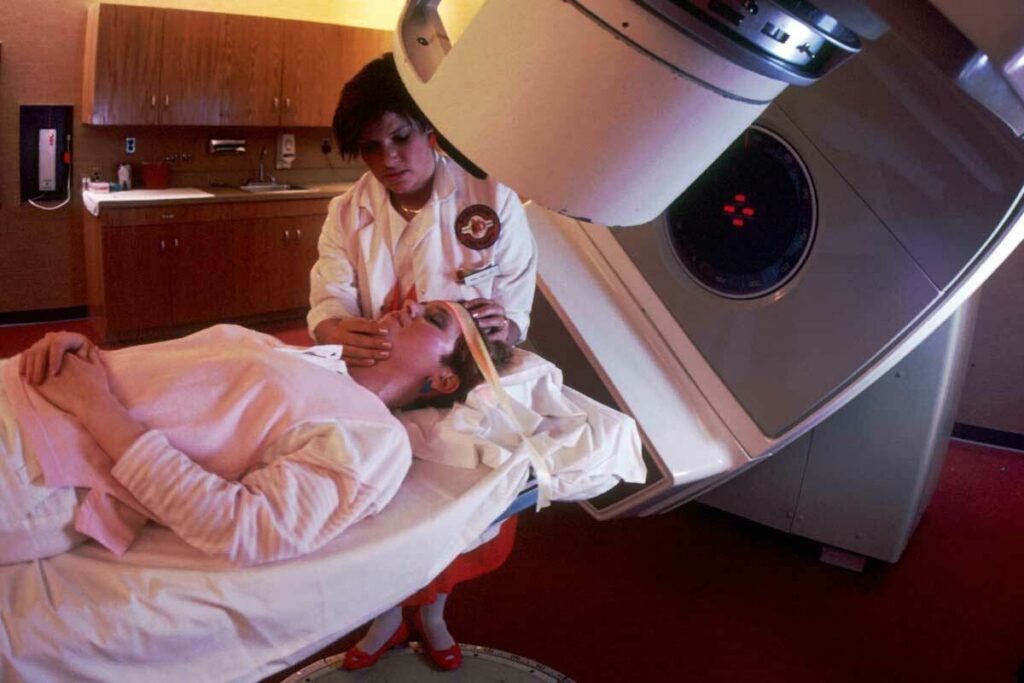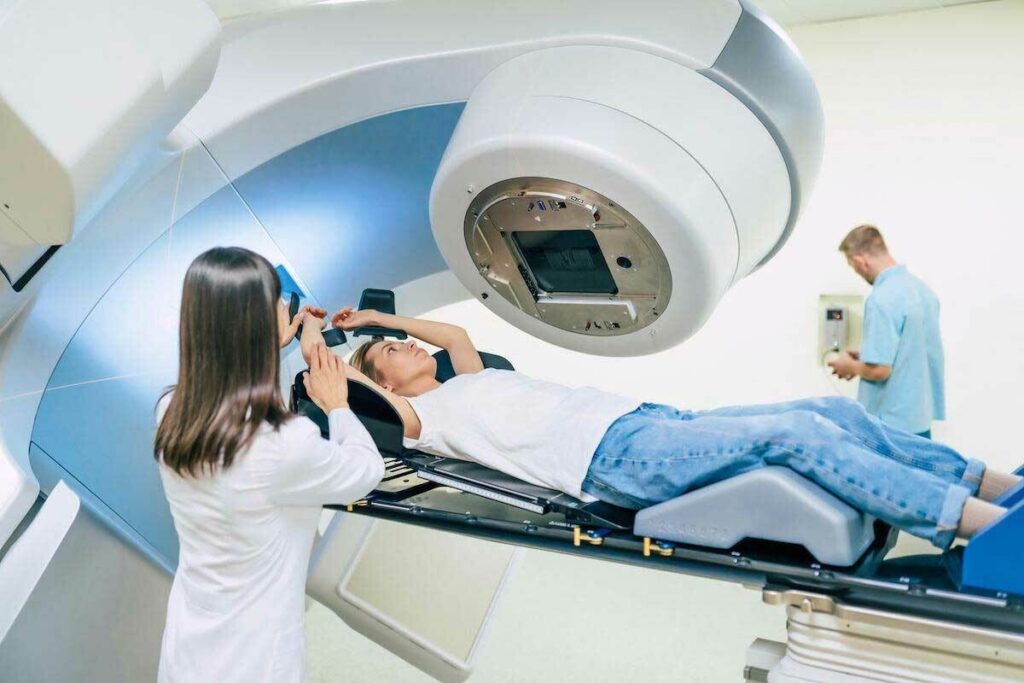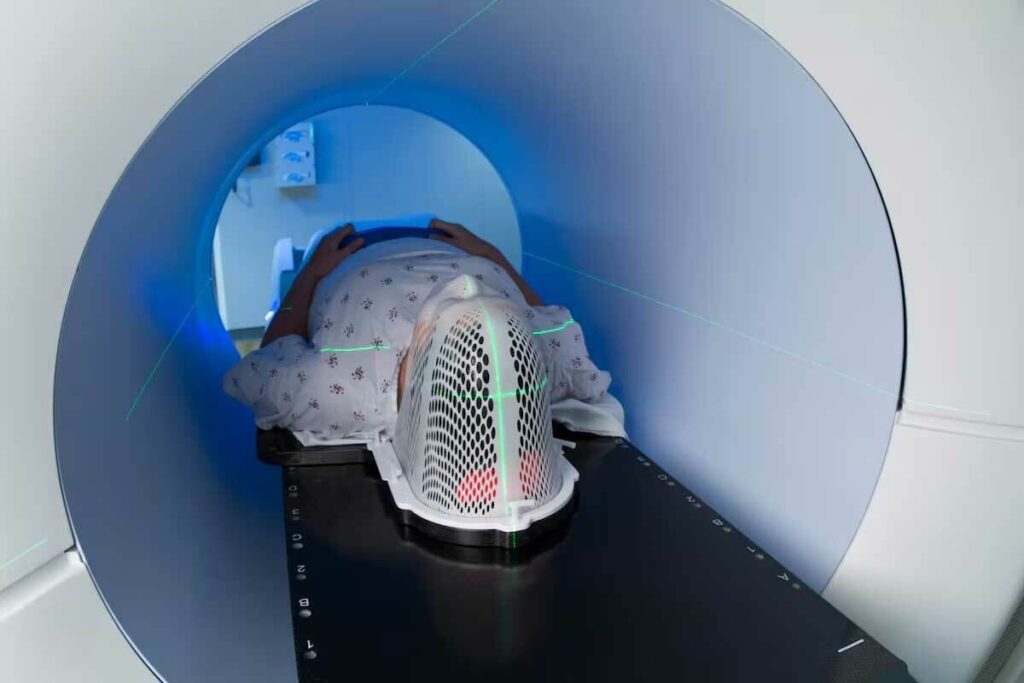
Knowing how long does a radiation treatment take is key for patients. The time needed changes based on cancer type, location, and treatment goals. Typically, external radiation therapy is given daily from Monday to Friday over five to eight weeks with breaks on weekends to allow healthy cells to recover. Each session usually lasts about 15 to 30 minutes, including setup, while the actual radiation delivery takes just a few minutes. Some treatments, like hypofractionated radiation, deliver higher doses in fewer sessions, shortening the total treatment time to about 4-5 weeks.
Whether it’s to cure, stop cancer from coming back, or ease symptoms, radiation therapy time can vary a lot. At Liv Hospital, patients get care that’s just right for them. They use the latest methods and have a team of experts.
Radiation therapy duration is affected by many things. This includes the cancer type and how far it has spread.

Learning about radiation therapy is key for those starting cancer treatment. It uses high-energy rays or particles to kill or slow cancer cells.
Radiation therapy damages cancer cells’ DNA, stopping them from growing. External beam radiation therapy is the most common. It comes from a machine outside the body, aiming at the cancer without touching the patient.
The treatment is given Monday to Friday for weeks. Most schedules last five to eight weeks. This helps spread out the radiation dose, reducing side effects.
There are two main types: external beam radiation therapy and internal radiation therapy (brachytherapy). External beam uses a machine outside the body. Internal radiation places radioactive material inside or near the tumor.
Each type has its own uses, benefits, and treatment times. Knowing these differences helps patients make better choices for their care.

The time it takes for a radiation treatment can vary. Knowing what to expect can help ease patient worries. A single session can last from 10 to 45 minutes.
Most sessions last between 15 to 30 minutes. This allows for setting up the equipment and positioning the patient correctly.
Several steps are taken during the session. First, the patient is placed on a treatment table. Immobilization devices might be used to keep the patient in the right spot.
The radiation therapist then works from a control room. They use X-rays or CT scans to check the target area.
The actual radiation delivery time is typically just a few minutes. The treatment feels like getting an X-ray. But the whole session includes getting ready, positioning, and checking steps.
The actual radiation time is usually 2 to 5 minutes. But the whole session is longer because of the prep and check steps. Knowing this can help manage patient worries about the treatment time.
In short, while the treatment itself is quick, the whole process takes longer. Patients should plan to spend about 15 to 30 minutes at the facility for each session.
External beam radiation therapy is a common cancer treatment. It’s important for patients to know about its duration and schedule. This method uses high-energy beams to kill cancer cells at the tumor site.
Most external radiotherapy lasts five to eight weeks, from Monday to Friday. This long treatment helps deliver a high dose of radiation safely. It also protects healthy tissues nearby.
The treatment plan is designed to give the tumor the right amount of radiation. The dose is split into smaller parts, given daily over the treatment period.
The usual schedule for external beam radiation therapy is Monday to Friday. Weekends off help normal cells recover. This reduces the risk of side effects.
Patients visit the radiation oncology department at the same time each day. The treatment team watches over the patient’s progress and makes any needed changes.
The weekend break is key in the treatment schedule. It lets normal cells recover and repair themselves. This makes the treatment easier for patients.
It also lowers the risk of long-term side effects. Healthy tissues get time to heal. The treatment team plans carefully to ensure the tumor gets enough radiation while protecting healthy tissues.
The time needed for radiation treatment changes a lot depending on the cancer type and where it is in the body. How long and complex the treatment is depends on the tumor’s details and how close it is to important organs.
The type and location of cancer greatly affect the treatment plan. Different cancers react differently to radiation. Also, where the cancer is can make the treatment more complex. For example, tumors near important areas might need more precise and possibly longer treatments.
After surgery, breast cancer patients usually get radiation. This treatment usually lasts 3 to 6 weeks, with treatments given daily, Monday to Friday. Some might get a shorter treatment, called hypofractionated radiation, which can be done in 3 weeks or less.
There’s also partial breast irradiation, which targets just the area around the tumor. This can be done in as little as 1 week. The choice between these options depends on the cancer’s stage, the patient’s health, and other factors.
Prostate cancer radiation treatment can vary. External beam radiation therapy (EBRT) usually takes 6 to 8 weeks, with daily treatments. Some newer methods, like Stereotactic Body Radiation Therapy (SBRT), can be done in just 5 days.
Brachytherapy, where tiny radioactive seeds are placed in the prostate, can be done in one session. Some types might need a few days in the hospital.
Head and neck cancers often need 6 to 7 weeks of radiation. This treatment is more complex because of the tumors’ closeness to important structures like the spinal cord and salivary glands.
Lung cancer treatment time depends on the tumor’s stage and location. Conventional radiation therapy can take 5 to 7 weeks. But SBRT can be done in just 3 to 5 sessions.
| Cancer Type | Typical Treatment Duration | Treatment Schedule |
| Breast Cancer | 3-6 weeks | Daily, Monday to Friday |
| Prostate Cancer | 6-8 weeks (EBRT), 1-5 days (SBRT/Brachytherapy) | Daily for EBRT, Single procedure or short stay for Brachytherapy |
| Head and Neck Cancer | 6-7 weeks | Daily, Monday to Friday |
| Lung Cancer | 5-7 weeks (Conventional), 3-5 sessions (SBRT) | Daily for conventional, 3-5 fractions for SBRT |
The main aim of palliative radiation therapy is to ease symptoms and enhance life quality for those with advanced cancer. It helps with pain, breathing, and swallowing issues. The treatment schedule varies based on the patient’s needs.
At times, just one radiation session can greatly reduce symptoms. This method is chosen for those with short life expectancies or mobility issues. Single-session radiation is effective for pain and other localized symptoms.
“Palliative radiation therapy can last from one session to three weeks,” showing the treatment’s flexibility. This flexibility is key in balancing treatment effectiveness with patient comfort and quality of life.
Many patients benefit from a short palliative radiation therapy course. This might involve several fractions over a few days to weeks. The exact duration depends on the patient’s health, tumor location, and symptoms.
One major challenge in palliative radiation therapy is finding the right balance. Treatment plans are designed to be tolerable and avoid harsh side effects. Patient comfort is a top priority, with treatment schedules and doses tailored to individual needs.
Experts say, “The goal is to balance effectiveness with patient comfort, ensuring the treatment is tolerable and beneficial.” This balance is vital in palliative care, focusing on improving life quality for those with advanced cancer.
Palliative radiation therapy is a valuable tool in managing advanced cancer. It offers relief from distressing symptoms and improves life quality. Understanding the different treatment timelines and schedules helps patients and caregivers make informed decisions about care.
Brachytherapy is a type of internal radiation therapy. It involves placing a radiation source close to the tumor. This method delivers a high dose of radiation locally, protecting healthy tissues.
Brachytherapy is divided into high-dose rate (HDR) and low-dose rate (LDR) types. High-dose rate (HDR) brachytherapy delivers radiation quickly, in just a few minutes. On the other hand, low-dose rate (LDR) brachytherapy gives radiation over several days.
LDR brachytherapy means the source stays in place for days. The patient must stay in the hospital to keep the radiation safe. The exact time depends on the treatment plan and the cancer type.
For prostate cancer, LDR seeds may stay in permanently. But the radiation they give off decreases over time.
The choice between outpatient and inpatient brachytherapy depends on the type and the patient’s condition. Outpatient brachytherapy is common for HDR, which is quick, nd the source is removed after.
Inpatient brachytherapy is needed for LDR, where the source stays longer. Hospital care is better for managing radiation safety and patient care.
In conclusion, brachytherapy treatment times vary a lot. It depends on HDR or LDR and the specific situation. Knowing these differences helps manage patient expectations and ensure the right care.
Radiation treatment for cancer is complex. It depends on many factors. These include the patient’s health, how sensitive the tumor is, and medical guidelines.
The patient’s health is very important. It affects how long and how often they get radiation therapy. Patients with health issues might need their treatment plans changed. This helps avoid bad side effects and keeps them safe.
A patient’s health is key in planning their radiation treatment. For example, patients with health problems might get treatment more slowly. This helps avoid making their condition worse.
“The patient’s overall health and medical history are critical in setting the right radiation treatment schedule.”
Doctors check the patient’s health carefully. They look at their medical history, current health, and physical exams. This helps doctors make a treatment plan that fits the patient’s needs.
The tumor’s sensitivity to radiation also matters. Tumors that are very sensitive to radiation might need shorter treatments. But less sensitive tumors might need longer or more intense treatments.
| Tumor Type | Sensitivity to Radiation | Typical Treatment Duration |
| Breast Cancer | Moderate | 5-6 weeks |
| Prostate Cancer | Low to Moderate | 6-8 weeks |
| Lung Cancer | Variable | 5-7 weeks |
Following medical guidelines is very important in radiation oncology. These guidelines make sure treatments are based on the latest research. They affect how long and effective the treatment is.
Medical guidelines help make care consistent everywhere. They are based on lots of research and clinical trials. This gives oncologists a clear plan for treatment.
Healthcare providers use patient health, tumor sensitivity, and medical guidelines to make personalized treatment plans. This helps get the best results and reduces side effects.
Many patients wonder when they’ll see the effects of radiation therapy on their cancer. The answer is in the slow process of how radiation works on tumors. It doesn’t kill cancer cells right away. It takes days or weeks for the DNA damage to be enough to kill them.
The effects of radiation therapy on tumors aren’t immediate. It takes time for the treatment to damage the DNA of cancer cells, leading to their death. This process can take weeks to months, during which visible changes accumulate gradually.
Timeline of Radiation Effects:
| Timeframe | Effects of Radiation Therapy |
| Initial Treatment Phase | DNA damage begins in cancer cells |
| Weeks 1-4 | Cancer cells start to die |
| Weeks 5-8 | Tumor reduction becomes noticeable |
| Post-Treatment | Continued tumor reduction and symptom relief |
The timeline for symptom relief can differ from the timeline for tumor reduction. Some patients may feel relief from symptoms like pain or difficulty swallowing within a few weeks. But visible tumor reduction on imaging studies may take longer to show up.
Regular follow-up schedules are key to checking how well radiation therapy is working. These schedules include imaging studies, clinical assessments, and patient reports. The frequency of follow-ups depends on the cancer type, treatment, and patient factors.
Follow-up Schedule Example:
By understanding the slow effects of radiation therapy and sticking to follow-up schedules, patients can better manage their treatment. They can also keep track of how well their radiation therapy is working.
Top institutions are leading the way in advanced radiation treatment. Places like Liv Hospital are at the forefront. They focus on patient care and follow international standards.
Liv Hospital is known for its all-in-one cancer treatment approach. It combines many medical fields to create custom plans. This ensures patients get state-of-the-art radiation therapy that fits their needs.
The team at Liv Hospital works together to make treatment plans. They aim to fight cancer well while reducing side effects. Thanks to new radiation technology, Liv Hospital offers treatments that work well and fast.
Liv Hospital and others follow strict international quality standards in radiation oncology. They use the latest research and best practices. This shows in their use of advanced technology and new treatment methods.
By sticking to these standards, Liv Hospital and others give patients the best care. They aim for the best results and keep patients safe. Safety is a big part of their work, making sure radiation therapy is safe.
Radiation oncology is always getting better, thanks to new tech and methods. Stereotactic body radiation therapy (SBRT) and intensity-modulated radiation therapy (IMRT) make treatments more precise and effective.
These new tools help patients get better faster. They also make treatment more efficient. As top centers keep using and improving these innovations, radiation therapy will get even better.
Knowing how long radiation treatment will last helps patients get ready. It makes them feel less worried and unsure.
Healthcare teams focus on each patient’s needs, from the first visit to aftercare. They work hard to improve care and meet high standards. This way, places like Liv Hospital can help patients get the best results from radiation therapy.
Patients will get a treatment plan made just for them. This plan considers their health and the cancer’s type and location. Understanding these details helps patients know what to expect during their treatment.
A typical radiation treatment session can last from 10 to 45 minutes. The actual time when radiation is delivered is usually just a few minutes.
External beam radiation therapy usually lasts five to eight weeks. Treatments are given Monday through Friday.
Palliative radiation therapy can last from one session to several weeks. It depends on the patient’s needs and the goal of symptom relief.
Brachytherapy treatment duration varies. Some treatments need the radiation source to stay in place for hours or days.
Seeing the effects of radiation therapy on tumors takes time. Visible changes may take weeks or months to appear.
Several factors affect radiation treatment duration. These include the patient’s health, the tumor’s sensitivity to radiation, and following medical guidelines.
Follow-up schedules are key during radiation therapy. They help monitor treatment success and make any needed adjustments.
Yes, radiation treatment can be personalized. Factors like the patient’s health and the cancer type, nd location play a role.
Radiotherapy duration varies by cancer type and location. Each cancer has its own treatment protocol.
Subscribe to our e-newsletter to stay informed about the latest innovations in the world of health and exclusive offers!
WhatsApp us